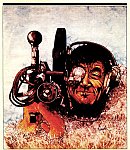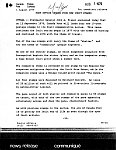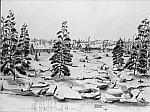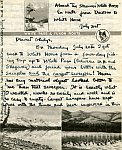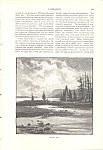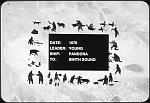Art and Artists
Author: Tom Novosel Page 1 | Page 2 | Page 3
In a newspaper article from 1977 entitled “In a Northern Light”, the sentiment emanating from Canada’s northern Arctic regions is that southern Canadians do not understand the identity or the realities facing northern peoples. The subjects of the piece are the National Film Board of Canada, the CBC and its northern programming, and Inuit filmmakers from the north, several of whom had recently made movies from the Inuit perspective depicting survival in the north and reflecting the Inuit way of life and culture. Inuk Mosha Michael’s film Asivaqtlin shows the detailed Inuit-style of skinning a caribou, while Andrew Steen’s Anaija and Karoo depicts the carving of an owl from whalebone (the Northwest Territories government sponsored this film and to use for educational purposes and to promote Inuit art). The problem with these types of northern films was that southern audiences did not have the patience to watch such detailed accounts of life; however, the thrust of these northern filmmaker’s is such that they would make the south recognize them and accept their style.
The aforementioned films have been said to have “no plot, no melodrama, no jolts. But, fascinating and haunting, [they] capture the feel of the North and the quality of its life.” The filmmakers also represent northern Inuit people at large, those afraid of cultural genocide and the youth becoming alienated from their culture and its traditional skills. These fears arise especially from watching programming that has nothing to do with their environment or their lifestyle, but instead perceptions and fantasies of the south. There is the sentiment that “the land is what the Inuit really like to see, stunning scenes of snowscapes and tundra, but also scenes of hunters telling of their exploits and catching fish, people building kayaks, making mukluks, and retelling legends.” Film, then, can be one of many artistic expressions northern Canadians, such as the Inuit, can use to depict their specific identity, cultural values, and northern realities.
One of the most important ways, then, for a group of people to express their history, cultural values and customs, folktales, legends, and identity is through artistic form; this reality holds true for the indigenous peoples of Canada’s northern regions, be they First Nations or Inuit. Newcomers to the area, however, have also been responsible for creating images of the Canadian north in the minds of the country’s southern population. The north has been a peculiar and important image for Canadians to grasp, one that also plays into our (mis)conceptions of identity as a northern nation; indeed, English littérateur Sherrill Grace suggests Canadians have still to come to terms with their “idea of north.” Canada’s northern population, though, is probably most adept at expressing the region’s realities. In fact, the Canadian government and Canada Post in the late 1970s created an Inuit stamp series where “the aim of Canada Post [was] to portray the Inuit way of life as seen through the eyes of Inuit artists.” Northern artistic realities not only include depictions of a vast, cold, empty, remote, and beautiful landscape as well as wilderness and recreation, but also depictions of a homeland for First Nations and Inuit where cultural markers such as totem poles, pictographs, Inuksuit, and igloos dot the landscape. Clothing, handicrafts, instruments and tools, sculptures, carvings, printmaking, drawings, pottery and ceramics, and traditional dance further establish cultural values and identity to their region.
While some of the earliest artistic visualisations of Canada’s northern lands came from expeditions, explorations, or publications, the use of postcards and letters have also been instrumental. These images were not necessarily meant to act specifically as works of art, yet they were influential as representations of the north and in how non-northerners might have imagined Canada’s northern lands to be. Many images seem only to suggest a region best suited for recreation, wildlife, or the aesthetic beauty of trees and mountains. The land’s harsh climate and its openness and vastness depicted by snow, icebergs, and water are also a familiar image of the north. Even though there are some images that existed early on that might have allowed non-northerners also to imagine the north as a homeland for its indigenous peoples, it was not a regular occurrence to find indigenous peoples depicted together with the land and wildlife. What we see, then, are mixed representations of the north that do give truthful and realistic accounts and artistic expressions of the region, but not the whole story; while these representations were not controlled by First Nations or Inuit peoples, they did already have, however, some of their own works of art all over the north for hundreds of years.
Totem poles are one of the strongest artistic historical monuments and documents for First Nations peoples. Totem poles depict the strength of First Nation peoples’ cultural identity and pride in their past, and each totem pole has a story and tells of achievements and rights; they are, therefore, treated with respect and honour. Totem poles signify another person born into the family; this new “person,” the totem pole, becomes the storyteller. Totem poles have told traditional stories and images representing a people’s origins and lineages, their rights and privileges, their supernatural experiences, their exploits and achievements, their acquisitions and territories, and their marriages and memorials; much of the time there is a symbolic relationship existing between natural phenomenon and the human group.
The totem pole’s meaning, however, has traditionally been decided upon by the artist or group of artists. Nowadays totem poles can tell a general story, a public story, which belongs to everybody; in many respects it is still a tool for education. In Canada, traditional totem poles are most commonly found in British Columbia along the coastline heading northwards and whenever a new totem pole appears it usually suggests a new native people identifying themselves and their territory. The people of the Kwakwaka’wakw nation, formerly Kwakiutl, have been very prominent in British Columbia, as one of their best known artists, Henry Hunt, attests.
It has been hard to antiquate the creation of some totem poles, but some of British Columbia’s earliest traditional totem poles were made during the fur-trade period, late 1700s to late 1800s, and suggested the wealth of Native villages; many totem poles, however, had already existed for hundreds of years and intimate Native wealth and affluence prior to the fur-trade with Europeans. Totem poles themselves usually contain carvings of birds or animals and the carved beings of the crest and legend portrayed on the totem poles have often been recreated in masks, headdresses, and ceremonial regalia worn by dancers, which brings the powers or skills of the bird or animal to life. Totem poles with human-like figures having arms outstretched signify the sign of welcome for visitors. Some, but not all, totem poles have plaques or information identifying the family or nation; sometimes family totem poles are memorials depicting special achievements of events in the deceased person’s family history. These days, though, there is also an abundance of totem poles not situated in a traditional context, but they still act as a strong reminder of the First Nations people and their long-standing presence on the land; they are normally called commercial poles (usually commissioned from sources outside the culture, such as governments, corporations, and institutions) and exist in such places as along highways and railways; at ferry terminals; in parks, gardens, and shopping plazas; outside hotels, public buildings, schools, museums, and tourist bureaus (where small miniature totem poles have been part of the tourist trade); and in quality Native gift shops and galleries for many years.

